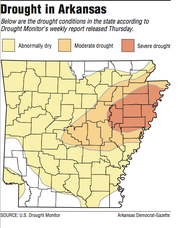Drought conditions have quickly worsened across the state, especially in eastern Arkansas, and forecasters say it will deteriorate even more rapidly in the coming weeks if there's minimal rainfall.
It's a reversal of an earlier assessment done by the National Drought Mitigation Center that said Arkansas appeared to be heading into spring "in good shape."
The center, an agency based at the University of Nebraska-Lincoln that evaluates drought conditions across the United States, reported Thursday that 84.5 percent of Arkansas is in some form of drought. Last week, 45.7 percent of the state was in drought.
Twelve counties in eastern Arkansas are considered in severe drought, a designation given to an area that is 2-4 inches deficient in rainfall over a 30-day period. Those counties are Craighead, Crittenden, Cross, Jackson, Lee, Mississippi, Monroe, Poinsett, Prairie, St. Francis, White and Woodruff.
"If we don't get any water, it's going to accelerate fast," said National Weather Service meteorologist John Lewis of North Little Rock. "The stream-flows for the state are alarmingly low for this time of year."
Lewis said the state has seen four consecutive months in which rainfall is below normal.
Climatologists had predicted a wet winter last fall after seeing evidence that an El Nino pattern was developing. The El Nino is the warming of Pacific Ocean waters that affects the jet stream and weather patterns across the United States.
Had the pattern continued to develop, Arkansas would have seen more rainfall in 2015. But that weather phenomenon didn't materialize, and the El Nino is now deemed to be in a "neutral" pattern.
Only 15.5 percent of the state is not in some form of drought. Three months ago, 74 percent of Arkansas was considered drought-free.
"I'm getting really concerned," said Joe Christian, a rice farmer from Cash in Craighead County. "We better get some rain pretty quickly, or we won't be able to sustain any water later this year. The wells are already drying out."
The weather service is calling for rain and snow for Sunday, Monday and Tuesday in Arkansas, but recent forecasting models show most of the moisture falling farther south then first believed and out of the area that needs the water the most.
Mitch Crow, an agent with the St. Francis County Cooperative Extension Service, said farmers are taking advantage of the dry conditions by turning soil with tractors and doing land-leveling this week.
"We've had dry springs before. Hopefully, this won't turn into a bad drought this summer," he said.
Brian Fuchs, a climatologist at the National Drought Mitigation Center, said "If eastern Arkansas gets normal precipitation from now on, we're still looking at deficits.
"There's been a steady expansion of drought conditions from eastern Arkansas into Kentucky, and we're not seeing anything in the future that will reverse this trend."
Dry conditions have caused the Arkansas Forestry Commission to classify the entire state as "moderate" for wildfire danger. Residents are urged to burn trash and debris in the early mornings and late evenings when there's less wind.
Adriane Barnes, a spokesman for the commission, said people should not burn when winds are more than 5 mph and the humidity is below 40 percent.
"Burning debris that gets out of control is the No. 1 cause for wildfires," she said.
The commission brought several air tankers into the state this week to help battle any fires. The state has two wildfire seasons. February is considered the beginning of first season because of the dry, windy conditions. The second wildfire season begins in late summer.
"The last two years were not considered high for fire danger because we had moisture," Barnes said. "We're ready for it, but there is a lot of [dry] fuel for fires. If the drought doesn't let up, we could be looking at quite an active fire year."
Fuchs said long-range forecasts call for average rainfall with normal temperatures for Arkansas for the next three months.
"The indications are there for an escalating drought," he said. "This is the time of year you need to see a large storm system come in, drop moisture and put the brakes on the drought. Nothing like that seems to be coming."
Lewis said once vegetation begins growing in the spring, it will further deplete what little moisture is available, making drought conditions escalate.
"It's all working against the farmer," Lewis said. "We'll see some moisture," he said of the Sunday storm system. "It won't be a gully washer, but anything will help. We'll take anything."
Christian said he used two tractors to turn soil on his 70-acre rice farm along the Cache River on Thursday. In previous years, he couldn't run that equipment in his fields because they'd become mired in the moist soil.
"That's just farming," he said. "You always have to deal with something."
State Desk on 02/13/2015
